Notes on the Emergence of the Ottoman Empire and Tamerlane
Notes on the Foundation of the Ottoman Empire
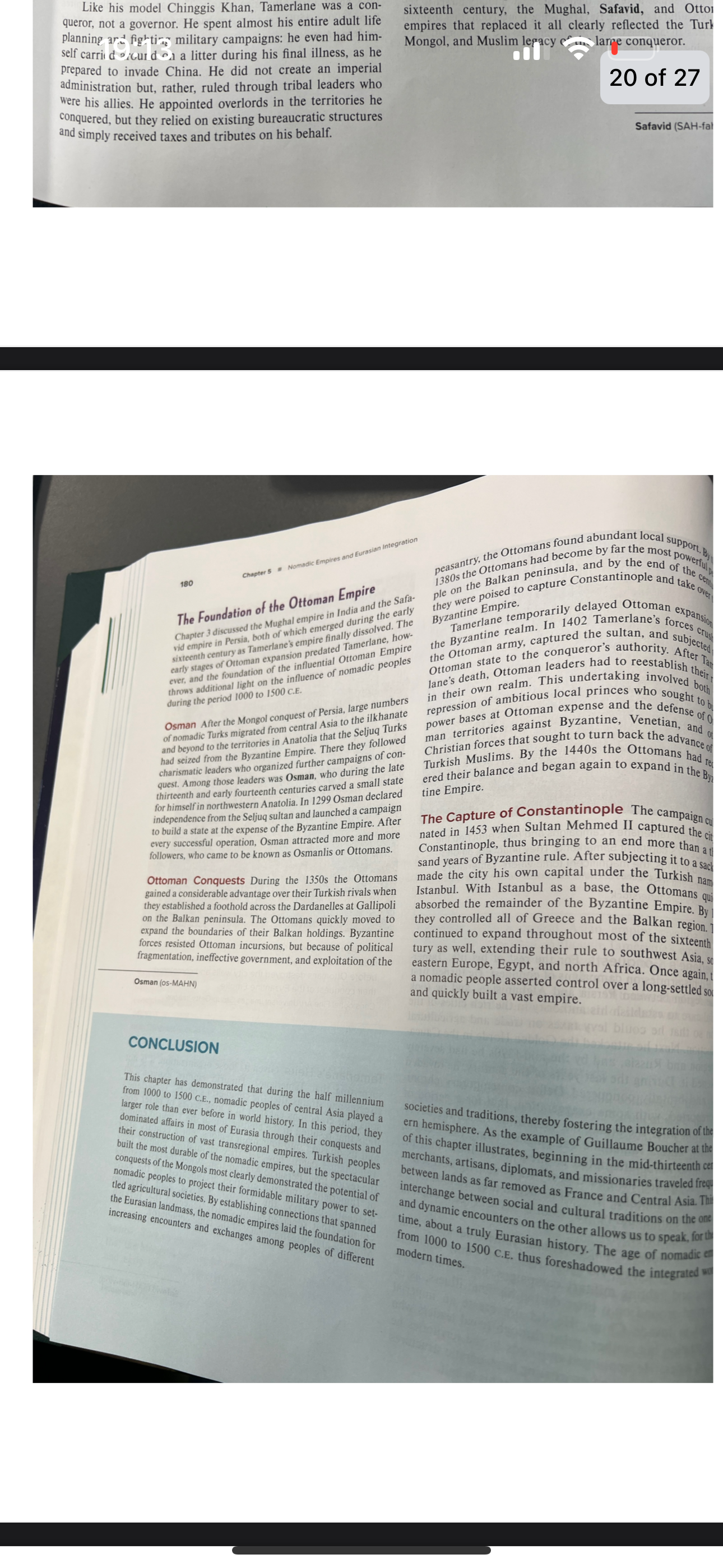
-
Tamerlane's Leadership Style
Tamerlane, like Chinggis Khan, was primarily a conqueror rather than a governor. This distinction is crucial because it highlights a pattern in leadership during this era where military expansion was prioritized over administrative organization. His reliance on tribal leaders for governance reflects traditional nomadic practices rather than the establishment of a formal bureaucracy. -
Osman's Role in Establishing Independence
Osman declared independence from the Seljuk sultans and founded a state that laid the groundwork for the Ottoman Empire. This underscores the importance of local leadership in the rise of empires and how regional dynamics can lead to significant historical changes. -
Ottoman Conquests
Initially, the Ottomans gained an advantage over their Turkish rivals by securing territory in the Balkans. The phrase "political fragmentation" indicates that the rival states were weak and lacked unity, which facilitated Ottoman expansion. This tactic of taking advantage of weaker neighbors is a common theme in empire-building throughout history. -
Capture of Constantinople
The fall of Constantinople in 1453 marked a significant turning point, allowing the Ottomans to control key trade routes and expand their territory further into Europe. The strategic importance of Constantinople as a base is emphasized, reflecting its role as a bridge between continents and cultures. -
Conclusion and Historical Impact
The chapter highlights how nomadic peoples played a vital role in shaping the political landscape of Eurasia from 1000 to 1500 CE. Their connections facilitated the exchange of culture and goods, which significantly influenced the development of modern states and trade networks.
Table of Key Events and Figures
| Event/Figure | Description |
|---|---|
| Tamerlane (Timur) | A conqueror who relied on tribal leaders. |
| Osman | Declared independence from the Seljuks and founded the Ottoman Empire. |
| Capture of Constantinople | A pivotal event that allowed for further Ottoman expansion into Europe. |
| Ottoman Conquests | Utilized rival political fragmentation to expand territory. |
| Nomadic Peoples (1000-1500 CE) | Influential in establishing trade and cultural exchanges across Eurasia. |
Reference:
Notes on Tamerlane's Conquests
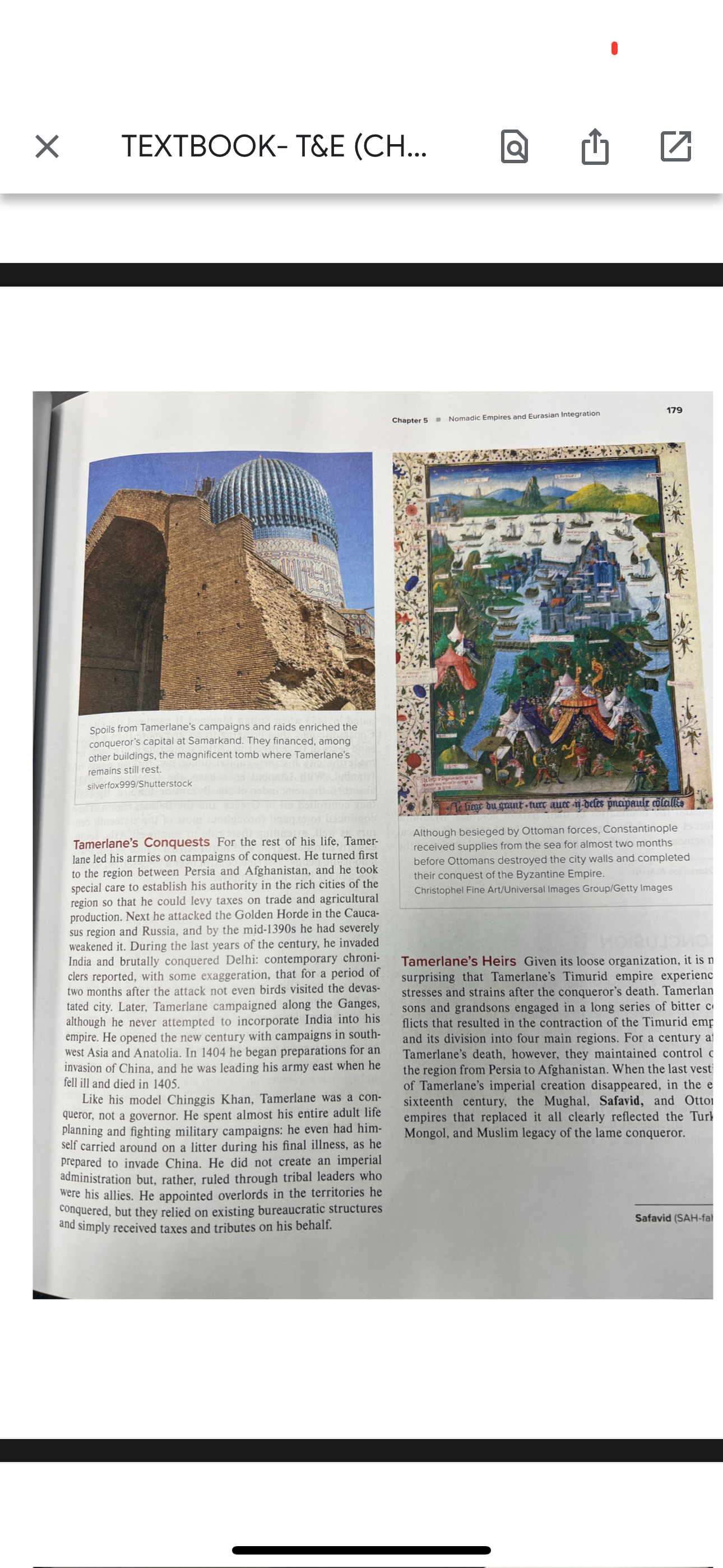
-
Tamerlane's Campaigns
Tamerlane, also known as Timur, focused heavily on military conquests throughout his life. His campaigns played a crucial role in shaping the political landscape of Central Asia.- Significance: The impact of his conquests extended beyond territorial expansion; they also influenced trade, culture, and the relationships between nations in the regions he invaded.
-
Capital at Samarkand
The spoils from Tamerlane's military campaigns enriched his capital, Samarkand. This wealth financed significant construction projects, including his magnificent tomb.- Cultural Impact: Samarkand became a center of culture and learning, reflecting the wealth and power held by Tamerlane. The region saw a blend of Persian, Turkish, and local cultures due to these influences.
-
Invasion Strategies
Tamerlane had a strategic approach to invasion, often targeting key regions like Persia, Afghanistan, and India. His methods included establishing authority and trade routes, which benefited his empire.- Historical Context: He emulated previous conquerors, such as Chinggis Khan, focusing on conquest rather than governance. This strategy allowed him to maintain control over vast territories through local leaders.
-
Decline and Legacy
After Tamerlane's death, his empire fragmented into several regions, each ruled by his descendants. This disintegration was marked by conflicts over control and power.- Further Developments: Despite the fragmentation, the cultural and political legacies of Tamerlane's rule continued to influence the region, setting foundations for future empires, including the Mughal and Safavid.
-
Byzantine Context
The text briefly mentions the siege of Constantinople by Ottoman forces, indicating a broader context of military conflict in the region during Tamerlane's time.- Relation to Tamerlane: This highlights the geopolitical dynamics of the period, with various empires vying for influence and control.
Table of Key Regions and Outcomes of Tamerlane's Conquests
| Region | Outcome |
|---|---|
| Persia | Consolidation of power and influence |
| Afghanistan | Establishment of authority |
| Ganges region | Campaigns that further expanded territory |
| Southwest Asia & Anatolia | Preparations for future invasions |
| China | Attempted invasion with armies |
This table summarizes the key regions Tamerlane focused on during his campaigns, highlighting the outcomes of his military actions and strategies.
Reference:
Notes on Tamerlane's Empire and After the Mongols
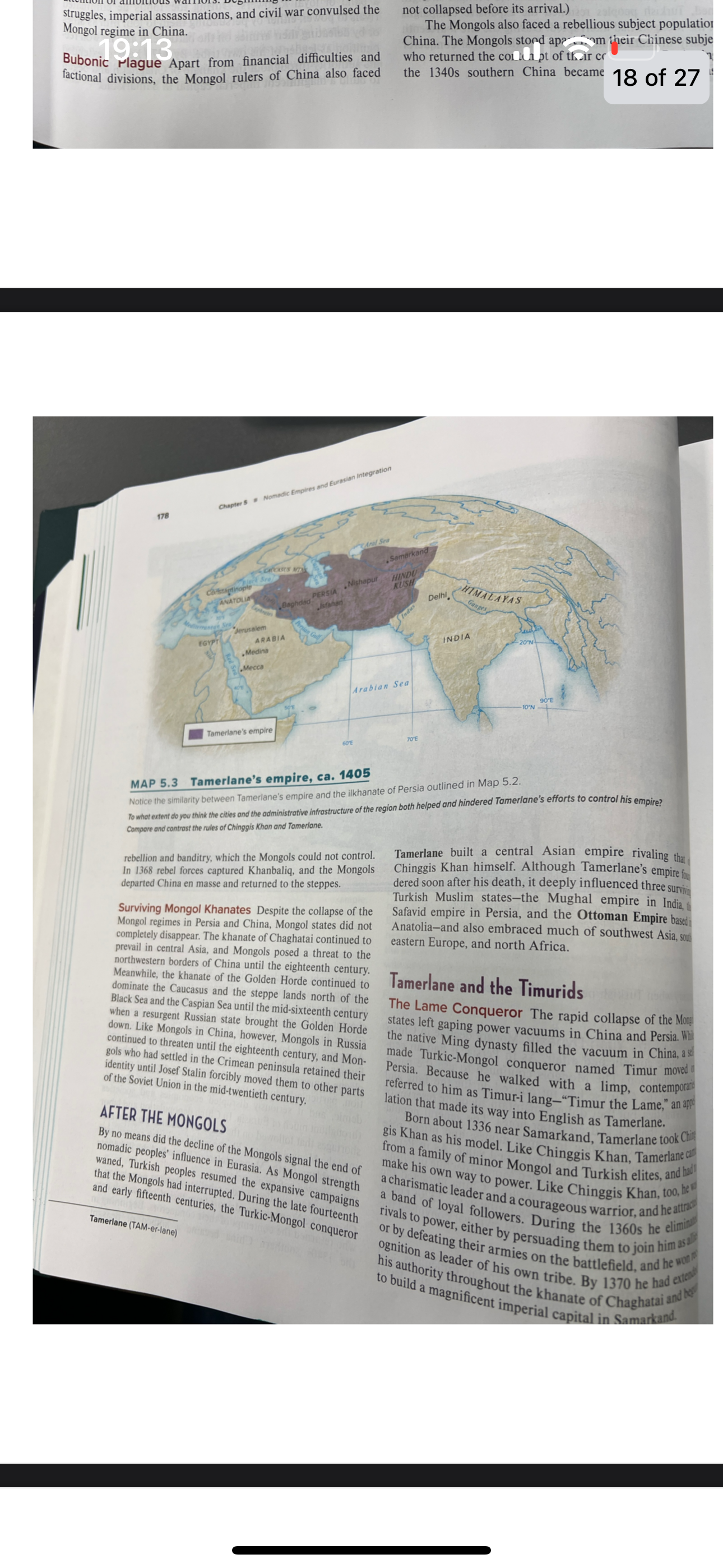
Tamerlane's Empire (ca. 1405)
- Geographical Extent: The map highlights Tamerlane's empire, which included significant areas of Central Asia, parts of Persia, and into the Indian subcontinent.
- Thought: Tamerlane's expansion mirrored many of the Mongol conquests, showing the legacy of Mongolian rule in the region.
- Additional Info: The mapping details major cities which served as cultural and administrative hubs during Tamerlane's rule.
Survival of Mongol Khanates
- Continuation of Mongol Influence: Despite the fall of the Mongol Empire, some khanates persisted into the 16th century.
- Thought: This continuity illustrates how the Mongol administrative and military systems had lasting impacts on the regions they once controlled.
- Additional Info: The Chagatai Khanate and the Golden Horde, for example, continued to shape political dynamics long after the decline of the central Mongol power.
Tamerlane and His Policies
- Rivalry with Chinggis Khan: Tamerlane tried to emulate Chinggis Khan, adopting similar military strategies and leadership styles.
- Thought: This rivalry indicates a reverence for the Mongolian heritage but also highlights Tamerlane's ambition to build his empire.
- Additional Info: His methods included military persuasion and forming alliances through strength, mirroring Mongol practices.
After the Mongols
- Turkish Influence Resurgence: The decay of Mongol power did not end the nomadic influence in Eurasia, as Turkish peoples regained strength.
- Thought: The shift back to Turkish leadership reflects the complex interactions between different nomadic groups in Eurasia.
- Additional Info: This period saw various Turkish states rising, indicating the fluid nature of power dynamics in the region.
Key Themes
- Imperial Fragmentation: The transition from Mongol dominance to a patchwork of successor states illustrates the challenges of maintaining control over vast territories.
- Cultural Exchange: Tamerlane's empire facilitated cultural exchanges between the East and West, influencing art, science, and trade.
Table Extracted from Image
| Map | Description |
|---|---|
| 5.3 | Tamerlane's empire, ca. 1405 |
This table summarizes the key focus of the provided image regarding Tamerlane's territorial influence and context.
Reference:
Notes on Mongol Empires and Eurasian Integration
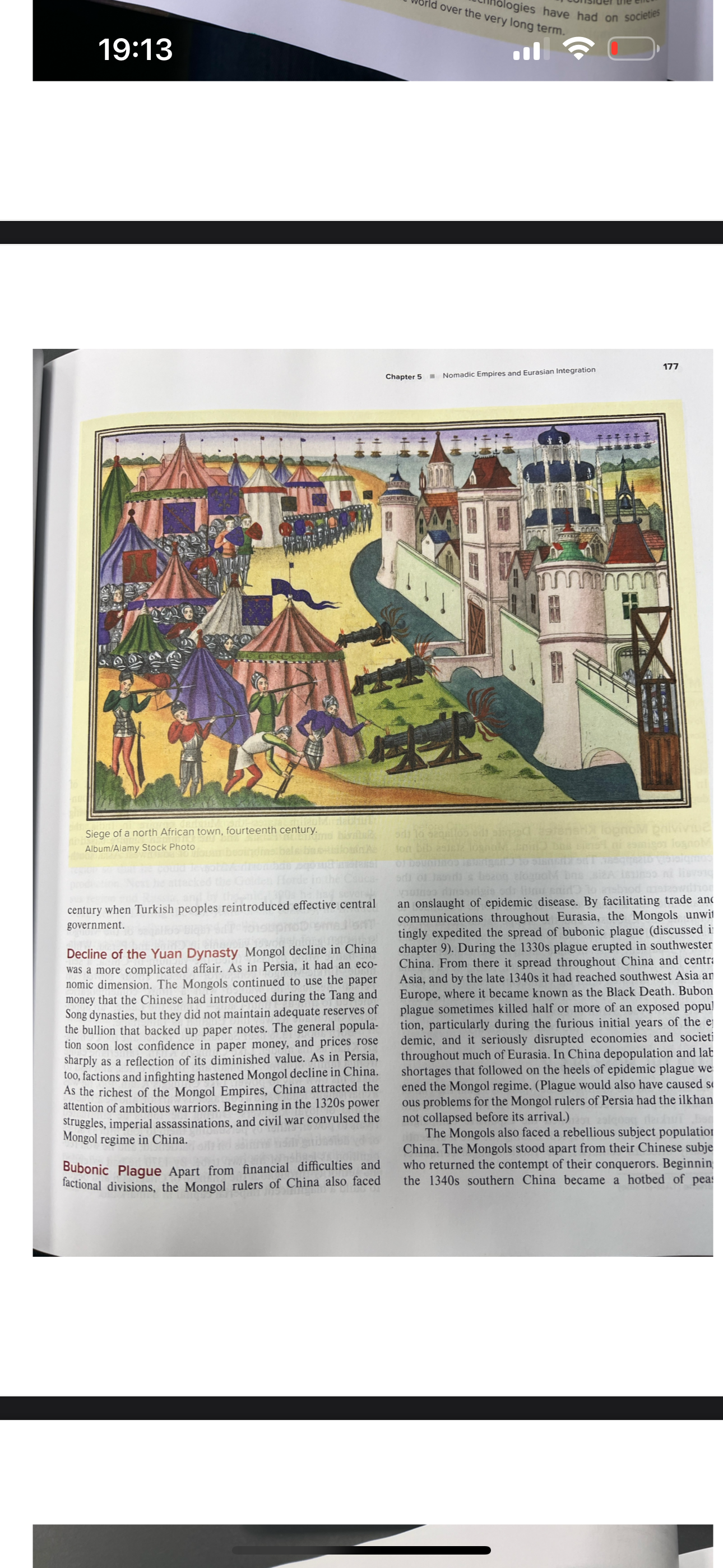
Siege of a North African Town
- Historical Context: The image depicts the siege of a North African town in the fourteenth century, illustrating the military conflicts of the era. This period was characterized by various invasions and the struggle for power among nomadic empires.
- Visual Elements: The scene shows tents, soldiers, and a fortified town, highlighting the military strategies employed during sieges.
Decline of the Yuan Dynasty
- Economic Challenges: The decline of the Yuan Dynasty (Mongol rule in China) is attributed to a complicated mixture of factors, including economic difficulties, and loss of confidence in paper money. The Mongols had used Chinese paper money but faced challenges in maintaining adequate reserves.
- Social Instability: The population experienced rising prices and loss of trust in the government, leading to civil unrest. This mirrors historical patterns of collapse in empires where public confidence is eroded.
Bubonic Plague
- Impact on Society: The Bubonic Plague severely affected the Mongol Empire, particularly in China where the plague contributed to significant societal changes. It not only caused a high mortality rate but also led to economic decline and social upheaval.
- Political Ramifications: The Mongol rulers faced challenges from rebellious populations and internal strife, which were exacerbated by the effects of the plague.
Summary
The image and accompanying text provide insights into the historical significance of nomadic empires, particularly the Mongols, and their interactions with settled civilizations. The decline of the Yuan Dynasty serves as a case study of how economic, social, and health crises can coalesce to lead to the fall of an empire.
Reference:
Notes on the Mongols and Trade
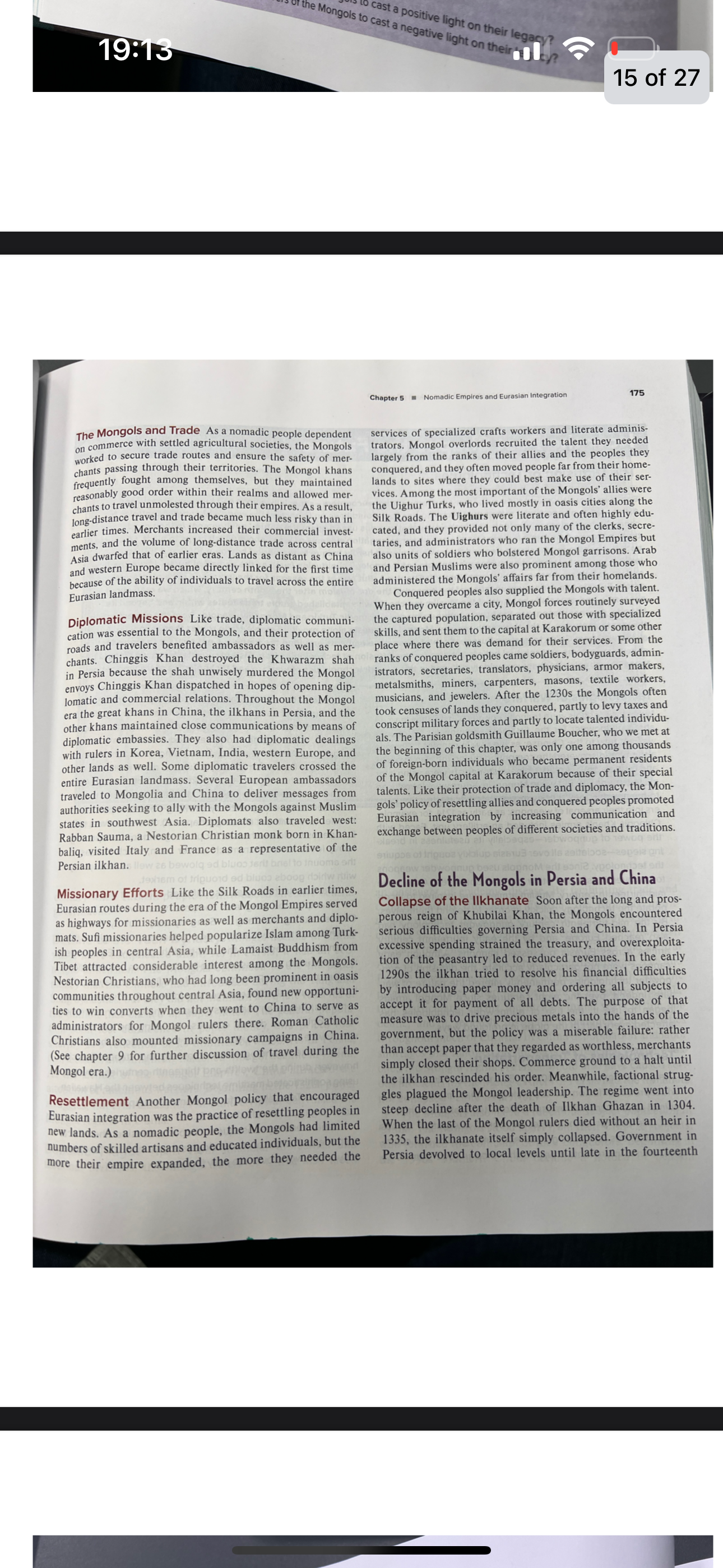
The Mongols and Trade
-
The Mongols were a nomadic people who relied on settled agricultural societies for trade.
- Thoughts: This dependence highlights the interconnectedness of nomadic and sedentary societies during this period. The Mongols played a crucial role in facilitating trade routes.
- Additional Info: Their interest in securing trade routes allowed for economic and cultural exchanges across Eurasia.
-
They worked to ensure the safety of merchants and travelers.
- Thoughts: The establishment of safe trade routes contributed to the prosperity of their empire and enhanced their reputation among other civilizations.
- Additional Info: This focus on trade security was part of their larger strategy to stabilize their regions post-conquest.
Diplomatic Missions
-
Diplomatic communication was vital for the Mongols.
- Thoughts: Effective diplomacy helped them manage a vast empire and integrate diverse cultures.
- Additional Info: They sent ambassadors and established diplomatic relations with various regions, indicating their strategic approach to governance.
-
Ability to communicate and maintain roads and trade routes was crucial.
- Thoughts: Good infrastructure directly facilitated trade and coordinated interactions with conquered peoples.
- Additional Info: The establishment of embassies and diplomatic missions reflects an organized government that valued both trade and diplomacy.
Missionary Efforts
- The Mongols supported missionary activities as a means of cultural integration.
- Thoughts: By promoting Christianity and Buddhism, they sought to convert various peoples, which might have helped in governance.
- Additional Info: Missionaries served as cultural ambassadors, leading to a rich exchange of ideas and customs across their territories.
Resettlement Policies
- Resettlement of artisans and educated individuals was important.
- Thoughts: By relocating skilled individuals, the Mongols could boost economic productivity and maintain control over conquered regions.
- Additional Info: This strategy illustrates the Mongols’ understanding of the importance of knowledge and skills in administration and trade.
Decline of the Mongols in Persia and China
-
Economic difficulties emerged, leading to debt and unrest.
- Thoughts: The introduction of paper money without proper backing showed a disconnect between financial policies and economic realities.
- Additional Info: This mismanagement contributed to the decline of central authority and instability in their rule.
-
Factional struggles weakened leadership after the death of significant rulers.
- Thoughts: Internal conflicts often destabilize regimes, making them susceptible to collapse, as seen in the Mongol context.
- Additional Info: The eventual disintegration of the ilkhans in Persia demonstrates how a lack of succession planning can lead to a power vacuum.
Summary
The text elaborates on the Mongols' interaction with trade, diplomacy, and cultural integration. Their strategies were fundamental in expanding their empire, but subsequent economic hardships and internal strife led to their decline. The details reflect a complex society adept in managing diverse populations and fostering commerce, but also hint at the vulnerabilities inherent in their governance structure.
Reference: